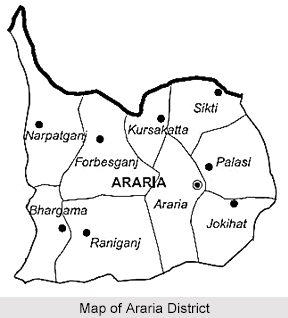 Araria District came into existence in 1990 on the auspicious day of Makar Sankranti. The district was formed after the division of the erstwhile Purnia District in Bihar into three districts, Purnia itself, Araria and Kishanganj. Araria has a very glorious history that relates it to the Mahabharata. It describes the conquest of Bhima in the eastern India and furnishes valuable information regarding the antiquity of the district.
Araria District came into existence in 1990 on the auspicious day of Makar Sankranti. The district was formed after the division of the erstwhile Purnia District in Bihar into three districts, Purnia itself, Araria and Kishanganj. Araria has a very glorious history that relates it to the Mahabharata. It describes the conquest of Bhima in the eastern India and furnishes valuable information regarding the antiquity of the district.
Earlier Araria was ruled by three important clans of Indian history. The important tribe of Kiratas governed the northern side, the eastern side was under the Pundras and the Angas ruled the western part.
Angas are believed to be the earliest inhabitants of the district, mostly in the area west of the Kosi River. These are the easternmost tribes. The Pundras are said to be the descendents of Saint Vishwamitra whereas the Kiratas were among the few most important ruling clans of that time. It is said that Raja Virata of Mahabharata had married a Kiranti woman who was the sister of Raja Kichaka, King of Kiratas.
During the Mauryan period this area formed the part of the Mauryan Empire. Later the district formed the part of the empire of Imperial Gupta Empire. A brief account of Araria and its people has been given by Hiuen-Tsang, the famous Chinese traveler, who visited about 640 A.D. As he saw it had a flourishing population and was studded with tanks, hospices and flowering groves. The land was low and humid with abundant crops and genial climate.
During the 7th century, the tract that has been included in the district was under Sasanka, the powerful king of Gauda. He was worshipper of Lord Shiva. As he was anti Buddhism he destroyed the Buddhist convents and scattered the monks carrying his persecutions towards the Nepalese hills.
Harshavardhana, the great Buddhist ruler of 7th century defeated Sasanka. But after the death of Harsha it seems likely that Araria became a part of Magadhan Empire under Aditya Sena. From the 9th to 12th century it was under the Pala kings and on their decline became subject to the Sena Dynasty rule of Bengal.
At the end of 12th century the Muslims under Bakhtiyar Khilji attacked Bengal shuddering Bihar. Bakhtiar removed the seat of government to Lakhnauti (Gaur) and from this centre Ghiasuddin Iwaz (1211-26) extended the area of Muslim control over the whole country called Gaur as well as Bihar. However due to the impassable network of rivers interspersed with large patches of jungle, the area of Muslim control could not extend to the northern portion of the erstwhile Purnia district, i.e., the present Araria district. Hence the present Araria district seems still to have been held by the hill tribes of Nepal.






